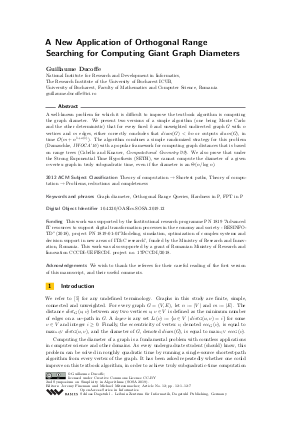A New Application of Orthogonal Range Searching for Computing Giant Graph Diameters
Author Guillaume Ducoffe
-
Part of:
Volume:
2nd Symposium on Simplicity in Algorithms (SOSA 2019)
Part of: Series: Open Access Series in Informatics (OASIcs) - License:
 Creative Commons Attribution 3.0 Unported license
Creative Commons Attribution 3.0 Unported license
- Publication Date: 2019-01-08
File

PDF
OASIcs.SOSA.2019.12.pdf
- Filesize: 470 kB
- 7 pages
Document Identifiers
Subject Classification
Keywords
- Graph diameter
- Orthogonal Range Queries
- Hardness in P
- FPT in P
Metrics
- Access Statistics
-
Total Accesses (updated on a weekly basis)
0Document
0Metadata
Abstract
A well-known problem for which it is difficult to improve the textbook algorithm is computing the graph diameter. We present two versions of a simple algorithm (one being Monte Carlo and the other deterministic) that for every fixed h and unweighted undirected graph G with n vertices and m edges, either correctly concludes that diam(G) < hn or outputs diam(G), in time O(m+n^{1+o(1)}). The algorithm combines a simple randomized strategy for this problem (Damaschke, IWOCA'16) with a popular framework for computing graph distances that is based on range trees (Cabello and Knauer, Computational Geometry'09). We also prove that under the Strong Exponential Time Hypothesis (SETH), we cannot compute the diameter of a given n-vertex graph in truly subquadratic time, even if the diameter is an Theta(n/log{n}).
Cite As Get BibTex
Guillaume Ducoffe. A New Application of Orthogonal Range Searching for Computing Giant Graph Diameters. In 2nd Symposium on Simplicity in Algorithms (SOSA 2019). Open Access Series in Informatics (OASIcs), Volume 69, pp. 12:1-12:7, Schloss Dagstuhl – Leibniz-Zentrum für Informatik (2019)
https://doi.org/10.4230/OASIcs.SOSA.2019.12
BibTex
@InProceedings{ducoffe:OASIcs.SOSA.2019.12,
author = {Ducoffe, Guillaume},
title = {{A New Application of Orthogonal Range Searching for Computing Giant Graph Diameters}},
booktitle = {2nd Symposium on Simplicity in Algorithms (SOSA 2019)},
pages = {12:1--12:7},
series = {Open Access Series in Informatics (OASIcs)},
ISBN = {978-3-95977-099-6},
ISSN = {2190-6807},
year = {2019},
volume = {69},
editor = {Fineman, Jeremy T. and Mitzenmacher, Michael},
publisher = {Schloss Dagstuhl -- Leibniz-Zentrum f{\"u}r Informatik},
address = {Dagstuhl, Germany},
URL = {https://drops.dagstuhl.de/entities/document/10.4230/OASIcs.SOSA.2019.12},
URN = {urn:nbn:de:0030-drops-100383},
doi = {10.4230/OASIcs.SOSA.2019.12},
annote = {Keywords: Graph diameter, Orthogonal Range Queries, Hardness in P, FPT in P}
}
Author Details
References
- A. Abboud, V. Vassilevska Williams, and J. Wang. Approximation and fixed parameter subquadratic algorithms for radius and diameter in sparse graphs. In SODA, pages 377-391. SIAM, 2016. URL: https://arxiv.org/abs/1506.01799.
-
J. Bentley and J. Friedman. Data structures for range searching. ACM Computing Surveys (CSUR), 11(4):397-409, 1979.

-
P. Berman and S. Kasiviswanathan. Faster approximation of distances in graphs. In WADS, pages 541-552. Springer, 2007.

- B. Block and M. Milakovic. Computing Diameters in Slim Graphs. Master’s thesis, Chalmers University of Technology, University of Gothenburg, Sweden, 2018. URL: http://publications.lib.chalmers.se/records/fulltext/255208/255208.pdf.
-
J. A. Bondy and U. S. R. Murty. Graph theory. Grad. Texts in Math., 2008.

- M. Borassi, P. Crescenzi, and M. Habib. Into the square: On the complexity of some quadratic-time solvable problems. Electronic Notes in Theoretical Computer Science, 322:51-67, 2016. URL: https://arxiv.org/abs/1407.4972.
- K. Bringmann, T. Husfeldt, and M. Magnusson. Multivariate Analysis of Orthogonal Range Searching and Graph Distances Parameterized by Treewidth. In IPEC. LIPIcs, 2018. to appear. URL: https://arxiv.org/abs/1805.07135.
-
S. Cabello and C. Knauer. Algorithms for graphs of bounded treewidth via orthogonal range searching. Computational Geometry, 42(9):815-824, 2009.

- T. Chan. Orthogonal Range Searching in Moderate Dimensions: k-d Trees and Range Trees Strike Back. In 33rd International Symposium on Computational Geometry (SoCG 2017), volume 77 of Leibniz International Proceedings in Informatics (LIPIcs), pages 27:1-27:15. Schloss Dagstuhl-Leibniz-Zentrum fuer Informatik, 2017. URL: http://drops.dagstuhl.de/opus/volltexte/2017/7226.
-
S. Chechik, D. Larkin, L. Roditty, G. Schoenebeck, R. Tarjan, and V. Vassilevska Williams. Better approximation algorithms for the graph diameter. In SODA, pages 1041-1052. SIAM, 2014.

-
P. Damaschke. Computing Giant Graph Diameters. In IWOCA, pages 373-384. Springer, 2016.

-
C. Jordan. Sur les assemblages de lignes. J. Reine Angew. Math, 70(185):81, 1869.

-
A. Meir and J. Moon. Relations between packing and covering numbers of a tree. Pacific Journal of Mathematics, 61(1):225-233, 1975.

-
L. Monier. Combinatorial solutions of multidimensional divide-and-conquer recurrences. Journal of Algorithms, 1(1):60-74, 1980.

-
L. Roditty and V. Vassilevska Williams. Fast approximation algorithms for the diameter and radius of sparse graphs. In STOC, pages 515-524. ACM, 2013.

